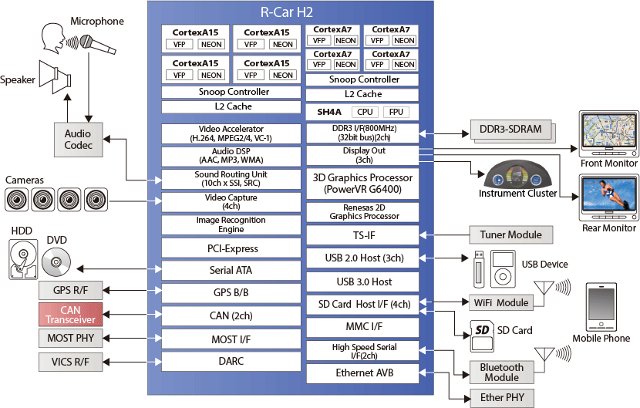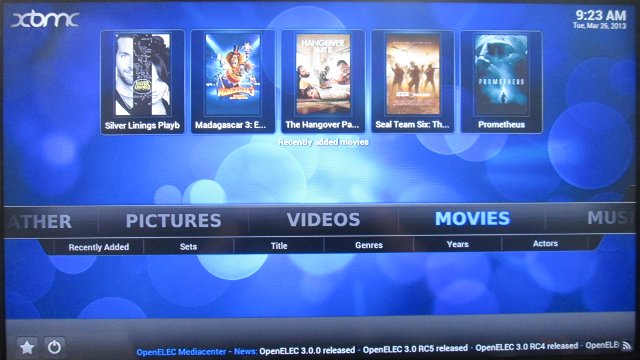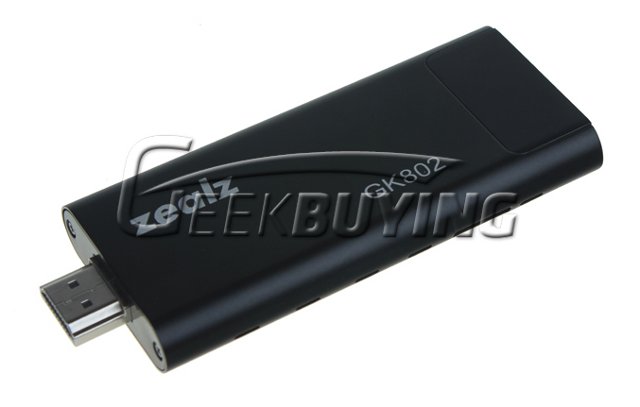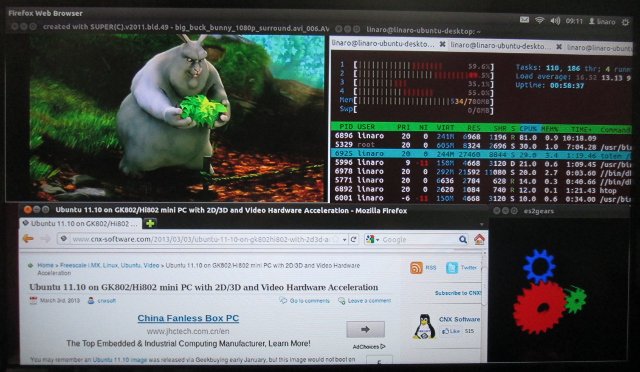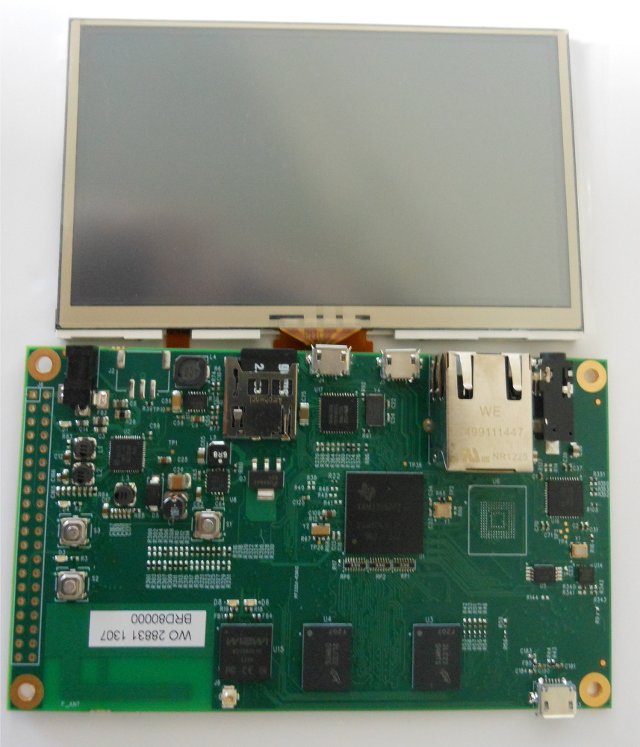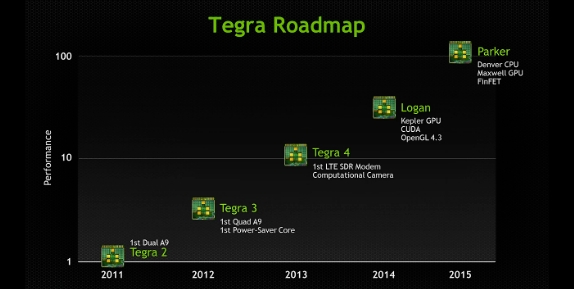Renesas announced a new automotive SoC called the R-Car H2 that features 4 Cortex-A15 cores together with 4 Cortex A7 cores (optional) in big.LITTLE configuration, as well as an Imagination PowerVR Series6 G6400 GPU. This SoC can optionally come with Renesas SH-4A, a real-time processing CPU core acting as a multimedia engine (MME) , and Renesas’ IMP-X4 core, a real-time image processing unit that enables developers to implement augmented reality application such as 360-degree camera views and image recognition. This Renesas processor is a multimedia power house, as it can handle 4x 1080p video en/decoding, including Blu-Ray support at 60 frames per second, as well as image/voice recognition and high-resolution 3D graphics with virtually no CPU usage. Here are R-Car H2’s specifications provided on Renesas website: Product number R8A7790x Power supply voltage 3.3/1.8 V (IO), 1.5/1.35 V (DDR3), 1.0 V (Core) CPU core ARM Cortex-A15 Quad ARM Cortex-A7 Quad (device […]
OpenELEC 3.0.0 on Raspberry Pi – Installation and Video Tests
Yesterday, OpenELEC developers announced the release of OpenELEC 3.0.0, a lightweight OS running XBMC Frodo 12.1 for several platforms including the Raspberry Pi (OpenELEC stands for Open Embedded Linux Entertainment Center). When the Raspberry Pi was initially released, I did not feel like testing it as a media center, mainly because of codecs limitations. But over time, this has improved with the availability of MPEG-2 and VC-1 codecs (for a fee), and GPU accelerated support for free codecs such as VP6 and VP8, so today I’ve tested to give a try and install OpenELEC 3.0.0 on my Raspberry Pi. I’ll first give installation instructions, then test several types of videos container formats, and video / audio codecs, as well as give some quick impression about the performance and stability of OpenELEC on this low cost board. Installing OpenELEC on Raspberry Pi To install OpenELEC, I basically followed the instructions provided […]
Zealz GK802 Is (Temporary?) Available for $69.99 on GeekBuying
Zealz GK802 is a mini PC based on Freescale i.MX6 Quad processor, with 1GB RAM, 8 to 16 GB internal memory (internal micro SD card). The main selling points of this HDMI dongle is that it’s the only currently available quad core processor (about to change), it’s hackable and unbrickable with easy access to the serial console, full support for Linux with hardware video decoding and 2D/3D acceleration (work in progress), and Freescale has released proper software and hardware development resources for the i.MX6 processor. As mentioned in my review of Hi802 mini PC, the downside is that Vivante GC2000 GPU performance is lower than the Mali-400 MP4 found in Rockchip RK3066 mini PC, and its price (usually above $90) is about double the price of Rockchip RK3066 mini PCs. We can’t do anything for Vivante GC2000 performance, but Roman found a coupon code “FVKIWVAG” on a Russian forum that […]
Ubuntu 11.10 Image for Hi802 / GK802 is Now Available for Download
About 2 weeks ago, Jasbir released an Ubuntu 11.10 image and installation instructions for GK802 and Hi802 mini PCs based on Freescale i.MX6. I could only find time to give it try yesterday and today. I’ll provide the steps I followed to install the image, and my quick first impressions of the stability and performance of this image. Installation Instructions I mainly followed the instructions provided by Jasbir, and run GParted to increased the partition size on my micro SD card. The image is for a 8 GB micro SD, but those instructions should work on 4GB SD card and greater, as the rootfs partition is only 3GB large. Download the Ubuntu 11.10 image, uboot, as well as the kernel image and modules in a Linux PC:
|
1 2 3 4 |
wget http://dl.miniand.com/jas-hacks/gk802/ubuntu_gk802.img.gz wget http://dl.miniand.com/jas-hacks/gk802/u-boot.imx wget http://dl.miniand.com/jas-hacks/gk802/uImage_3.0.35-0269_cpu_freq wget http://dl.miniand.com/jas-hacks/gk802/modules_3.0.35-02695.tar |
Copy the image, uboot and the kernel to the micro SD card by typing the commands below:
|
1 2 3 4 |
gzip -d ubuntu_gk802.img.gz sudo dd if=ubuntu_gk802.img of=/dev/<sd_device> sudo dd if=u-boot.imx bs=1k seek=1 of=/dev/<sd_device> && sync sudo dd if=uImage_3.0.35-0269_cpu_freq of=/dev/<sd_drive> bs=1048576 seek=1 && sudo sync |
Replace /dev/<sd_device> by your […]
Gumstix Unveils $249 Pepper Single Board Computer Powered by TI Sitara AM3359
Gumstix has just announced a new single board computer for Linux embedded development and experimentation. Pepper is powered by Texas Instruments Sitara AM3359 Cortex A8 processor, and comes with 512MB DDR2, WiFi and Bluetooth connectivity, a 4.3″ LCD touchscreen and more. Gumstix Pepper Key features: Processor – Texas Instruments Sitara AM3359 Cortex A8 processor up to 720 MHz System Memory – 512MB DDR2 Storage – microSD card slot (No flash) Connectivity: Wifi – 802.11 b/g/n 10/100/1000M Ethernet Bluetooth 3.0 Display – Samsung 4.3″ LCD resistive touchscreen (480 x 272) USB – 2x USB OTG connectors Expansion headers – For I2C, SPI and UARTs GPIO-controlled push buttons and LEDs Sensors – 3D Accelerometer (ST LIS33DE) Power – 5V Since there’s no flash, a microSD is used to boot the board. Gumstix provides a Linux distribution built with the Yocto Project which you” eventually be able to download here (the page is […]
SECO mITX GPU DevKit Features Nvidia Tegra 3, Supports CUDA 5
SECO mITX GPU DEVKIT is a GPU computing development kit that provides a Mini-ITX Qseven 2.0 carrier board (SECO mITX Carrier Board) with a Nvidia Tegra 3 powered Qseven SoM (QuadMo747-X/T30). The carrier board provides a PCI-e x16 connector (PCI Express x4) intended to allow the connection of CUDA 5 enabled desktop graphics boards. Embedded Control Europe reports that the platform will support Nvidia Kayla platform. The main specifications of the platform are as follows: CPU – Nvidia Tegra 3 Quad-Core ARM Cortex A9 GPU – TBD. But you should be able to insert Nvidia graphics card via the PCI-e x16 connector (PCI Express x4) on the mini-ITX board Memory – 2 GB Storage – 4 GB eMMC + 1x SATA 2.0 Connector Network – 1x Gigabit Ethernet USB – 3x USB 2.0 + 1 OTG port Display – HDMI The platform will support Linux Ubuntu , as well as […]
Nvidia Updates its Tegra Roadmap with Parker 64-Bit ARM SoC, Unveils Kayla CUDA Development Platform
Nvidia has given an update about the roadmap for its Tegra processor at the GPU Technology Conference in San Jose, California. Tegra 4 will still be followed by Logan (Tegra 5) as planned with a Kepler GPU and support for CUDA and OpenGL 4.3, but “Stark” has been replaced by “Parker” (Tegra 6) which will be the first 64-Bit Tegra processor based on Denver CPU, Maxwell GPU and make use of Finfet transistors. Logan will be available in 2014, and Parker should be available in 2015 with 100 times more performance than Tegra 2. With this kind of performance, the separation line between desktop and mobile processors will be gone. Nvidia also unveiled Kayla (“Logan’s girlfriend”), a development platform for CUDA and OpenGL based on Tegra 3 quad-core ARM processor and a Kepler GPU connected via a PCI express slot. Jen-Hsun Huang (above) showcased Kayla performance by running real-time ray […]
Embedded Android Training Workshop At Linaro Connect Asia 2013
Karim Yaghmour, Opersys’ CEO, gave 4 training sessions dealing Embedded Android at Linaro Connect Asia 2013, in Hong Kong, earlier this month. Charbax filmed those 4 40 to 50 minutes session with excellent video and audio quality, so I encourage you to watch all sessions if you are interested in this topic. The presentation slides are available on Slideshare. The first training session is entitled “Android Internals”, and Karim introduces Android’s overall architecture, following the agenda below: Android Concepts Framework Intro Overall Architecture System startup Linux Kernel Hardware Support Native User-Space Dalvik JNI System Server Calling on Services Activity Manager Binder HAL Stock AOSP Apps Case-in-Point The second session “Working with the AOSP” deals with the following key points: Tools and location Content Building Build tricks Build system architecture Output images Using adb Custom toolchains and dev kits Compatibility Test Suite Basic hacks The third session entitled “Native Android user-space” […]


